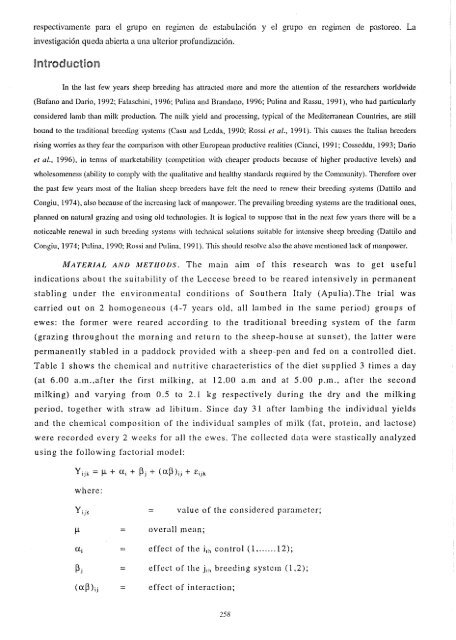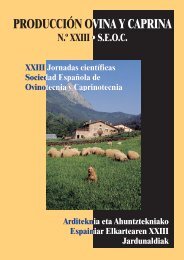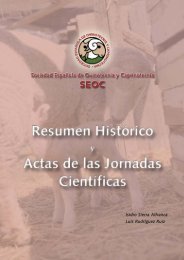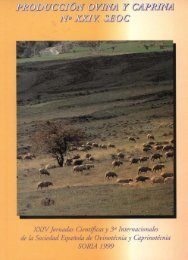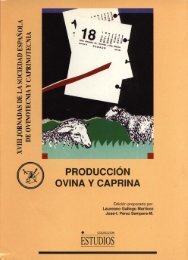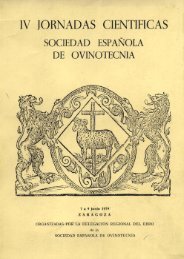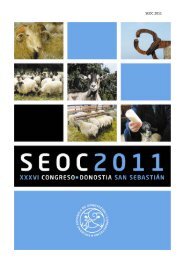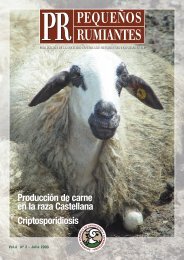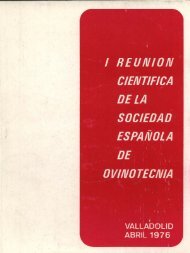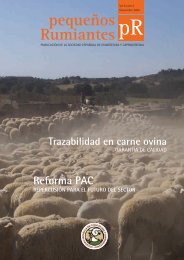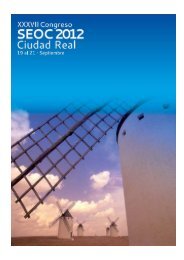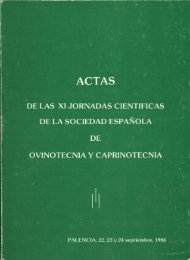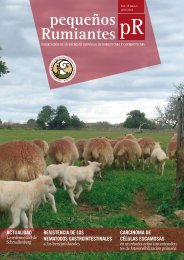- Page 3 and 4:
XXII JORNADAS DE LA SOCIEDAD ESPAÑ
- Page 5:
PRÓLOGO Prorrogar un libro siempre
- Page 8 and 9:
Secretarios D. Santiago Mayans Váz
- Page 10 and 11:
Por otra paite, y a lo largo de las
- Page 13:
ALIMENTACIÓN
- Page 16 and 17:
Material y métodos El estudio se h
- Page 18 and 19:
PB 11% linní fi 4% Out CC 19% SÍ2
- Page 20 and 21:
Lignina 10%-25% CC>55% Hem
- Page 22 and 23:
Anexos Taela 2: Composción químic
- Page 24 and 25:
The sheep species was selected main
- Page 26 and 27:
Table 1 - Percent and chemical comp
- Page 28 and 29:
it Table 3 -Initial and final live
- Page 30 and 31:
Bibliografía ANTONGIOVANNIM. (1994
- Page 32 and 33:
this implies a reduction in the dig
- Page 34 and 35:
The lowering of coefficients of dig
- Page 36 and 37:
Table 2 - Apparent digestibility co
- Page 38 and 39:
Tabie 6 - Dissection of pelvic iím
- Page 41 and 42:
RESPUESTA DE OVEJAS MERMAS A DIETAS
- Page 43 and 44:
Referencias bibliográficas HERNÁN
- Page 45:
Cuadro 3.- Respuesta del peso vivo
- Page 48 and 49:
al 30 (Bocquier el al., 1990). No o
- Page 50 and 51:
Cuadro 1.- Efecto de un pienso inte
- Page 52 and 53:
considerar socialmente insostenible
- Page 54 and 55:
BLIBL10GRAFÍA. BOCQUIER, R; THEREZ
- Page 56 and 57:
Cuadro 3. Consumos anuales (kg) y c
- Page 58 and 59:
Autofrenar dicho consumo por el pro
- Page 60 and 61:
SANZ, E., BABOT, D., CUBILO, D. y U
- Page 62 and 63:
Cuadro 2. Evolución del consumo 1
- Page 65 and 66:
EL EMPLEO DE LAS BRáCTEAS DE ALCAC
- Page 67 and 68:
Los aspectos de cantidad y calidad
- Page 69 and 70:
de tipo tradicional, ventilado, a u
- Page 71 and 72:
Bibliografía Annuario deli'Agricol
- Page 73 and 74:
Tabla 1 - Composción química de l
- Page 75 and 76:
Tabla 3 - Resuitatdos en el matader
- Page 77 and 78:
Tabla 5 - Incidencia percentuai de
- Page 79 and 80:
Tabla 8 - Composición qu ímica de
- Page 81 and 82:
INFLUENCIA DEL PROCESO DE OBTENCIÓ
- Page 83 and 84:
RESULTADOS Y DISCUSIÓN La composic
- Page 85 and 86:
IBLIOGRAFI. A.O.A.C. 1980. Official
- Page 87:
Tabla 2 : Degradación de la materi
- Page 90 and 91:
enero y febrero, es utilizado en el
- Page 92 and 93:
espectivamente. La degradabilidad p
- Page 94 and 95:
Vanderhaeghe, S. et Biston, R. 1987
- Page 96 and 97:
Tabla 3. Cinética de digestión y
- Page 99 and 100:
PARTICULARIDADES DE LA ALIMENTACIÓ
- Page 101 and 102:
de las necesidades del animal. En z
- Page 103 and 104:
diferencias reales en los fenómeno
- Page 105 and 106:
corporales (1,2 kg al mes de media)
- Page 107 and 108:
Por tanto, parece preferible usarlo
- Page 109 and 110:
Una estrategia alimenticia se debe
- Page 111 and 112:
Es bien sabido que las cabras que r
- Page 113 and 114:
algo más tarde, tres semanas despu
- Page 115 and 116:
CONCLUSIÓN La gestión de la alime
- Page 117 and 118:
DIEPENDAELE J., 1995. Fourrage ou c
- Page 119 and 120:
MORAND-FEHR P., 1989. Goat Nutritio
- Page 121 and 122:
ROUSSELOT M.C., BROQUA C.B., ARANJO
- Page 123 and 124:
Cuadro 1. APORTES RECOMENDADOS EN M
- Page 125:
ELABORACIÓN QUESERA Y CALIDAD DE L
- Page 128 and 129:
TABLA 1 Censo de hembras mayores de
- Page 130 and 131:
El contenido en grasas osciló entr
- Page 133 and 134:
ESTABLECIMIENTO DE LAS BASES PARA L
- Page 135 and 136:
MATERIAL Y MÉTODOS: El presente es
- Page 137 and 138:
TABLA 2 CARACTERÍSTICAS QUÍMICAS
- Page 139:
BIBLIOGRAFÍA: ARROYO Y GARCÍA, 19
- Page 142 and 143:
INTRODUCCIÓN Debido al establecimi
- Page 144 and 145:
En lo que a la composición de medi
- Page 146 and 147:
todos los componentes de la leche (
- Page 148 and 149:
BIBLIOGRAFÍA Alais CU., 1986. "Cie
- Page 151:
PEQUEÑOS RUMIANTES Y DE3AÍLRÜLL
- Page 154 and 155:
. INTRODUCCIÓN La Ley de Espacios
- Page 156 and 157:
(FAO, 1991). Sin embargo, las técn
- Page 158 and 159:
granja" según Quittet, 1990), sobr
- Page 160 and 161:
4.1.2. Sistema sin pastos. Este sis
- Page 162 and 163:
Erica, Myrica e Ilex. Dentro del Mo
- Page 164 and 165:
permitiría la obtención de cierto
- Page 167:
SELECCIÓN
- Page 170 and 171:
El control se reali2ó una vez al m
- Page 172 and 173:
TABLA: 2 ANÁLISIS MULTIFACTORIAL D
- Page 174 and 175:
TABLA: 7 ANÁLISIS SIMPLES DE LA PR
- Page 177:
Tabla II. Pesos al destete de los c
- Page 180 and 181:
En la bibliografía consultada que
- Page 182 and 183:
BIBLIOGRAFÍA: BOICHARD, D.; BOULOC
- Page 184 and 185:
MATERIAL Y MÉTODOS: Este trabajo s
- Page 186 and 187:
TABLA: 2 ANÁLISIS MULTIFACTORIAL D
- Page 188 and 189:
TABLA: ANÁLISIS SIMPLES DE LA PROD
- Page 191 and 192:
ESTUDIO DE LA COMPOSICIÓN :°J^"Á
- Page 193 and 194:
TRATAMIENTO ESTADÍSTICO La compara
- Page 195 and 196:
BIBLIOGRAFÍA Baldi.A.; Cheli,R; Co
- Page 197:
Componente Modelo matemático (T :
- Page 200 and 201:
Los perfiles metabólicos se ven af
- Page 202 and 203:
col. (1990), Bennis y col. (1991, 1
- Page 204 and 205:
Cuadro 1 : Valores medios y desviac
- Page 207 and 208: EFECTOS DEL SISTEMA DE PRODUCCIÓN
- Page 209 and 210: El ensayo se realizó en la finca V
- Page 211 and 212: los lotes 1-2-3 respectivamente). E
- Page 213 and 214: CONCLUSIONES. Suplementación prepa
- Page 215 and 216: Cuadro 1. GANANCIAS MEDIAS DIARIAS
- Page 217 and 218: Cuadro 3. Valores Medios y Desviaci
- Page 219 and 220: CARACTERIZACIÓN TÉCNICA DE EXPLOT
- Page 221 and 222: de sistemas de producción (Deffont
- Page 223 and 224: explotaciones con menor productivid
- Page 225 and 226: Esto hace que presente el menor cos
- Page 227 and 228: Del total de corderos muertos, un 3
- Page 229 and 230: Tabla 1. Correlación de las variab
- Page 231: Tabla 3. Valores medios de otras va
- Page 234 and 235: factores obtenidos mediante ei Aná
- Page 236 and 237: arrendados e intensificadas con rel
- Page 238 and 239: El Grupo 2 engloba 13 explotaciones
- Page 240 and 241: El Grupo 6 lo definen 3 explotacion
- Page 242 and 243: Tabla 1. Correlación de las variab
- Page 244 and 245: Tabla 3. Valores medios de otras va
- Page 246 and 247: - Incentivar el asociacionismo entr
- Page 248 and 249: GANADERÍA TERMINO N a . Total Ov.>
- Page 250 and 251: moruecos fuera de la época de mont
- Page 252 and 253: existentes en la explotación. Al f
- Page 254 and 255: BIBLIOGRAFÍA. -Departamento de Eco
- Page 256 and 257: Superficie Superficie Cultivo Culti
- Page 260 and 261: Literature cited BÚFANO G., DARÍO
- Page 262 and 263: Tabla 2-Performances a los controle
- Page 264 and 265: Tabla 4 - Composición química y r
- Page 266 and 267: llevado a esta región a padecer gr
- Page 268 and 269: nariz es plana. No presenta cuernos
- Page 270 and 271: autor en la que se define perfectam
- Page 272 and 273: fundamental del censo, que se puede
- Page 274 and 275: prendas artesanales, es un recurso
- Page 276 and 277: Leche 120 % Grasa % Protuína Lacto
- Page 278 and 279: (estrategias de mercado, medidas ar
- Page 280 and 281: SAT Canarias. 1994. Ovino autócton
- Page 283 and 284: CORRELACIÓN ENTRE TESTOSTERONA Y A
- Page 285 and 286: Nuestros resultados no están total
- Page 287 and 288: Tabla 1 Correlaciones máximas entr
- Page 289 and 290: EFECTO DE LA SUBNUTRICIÓN SOBRE LA
- Page 291 and 292: morueco vasectomizada con el fin de
- Page 293 and 294: desarrollo embrionario en el cuerno
- Page 295 and 296: Longcope, C, Abend, S., Bravennan,
- Page 297 and 298: Figura 2.- Concentración de proges
- Page 299: Tabla 2.- Diámetro del cuerpo y cu
- Page 302 and 303: . climi temperati dell'einisfero se
- Page 304 and 305: gravidanza effettuata circa 50 gior
- Page 306 and 307: O.Minoia P., Sciorsci R.L., Desiant
- Page 308 and 309:
Son muy pocos los trabajos publicad
- Page 310 and 311:
APLICACIÓN DE LA INSEMINACIÓN ART
- Page 312 and 313:
Los resultados obtenidos en fertili
- Page 314 and 315:
Gráfico n 1: COMPORTAMIENTO DE LOS
- Page 316 and 317:
Gráfico n e 3: VOLUMEN (Tipo étni
- Page 318 and 319:
Gráfico n a 5: CONCENTRACIÓN (Tip
- Page 320 and 321:
MATERIAL Y MÉTODO: Se utilizaron 6
- Page 322 and 323:
Hay que destacar que el efecto de p
- Page 324 and 325:
m o 1 • i U__i_l | vr £ 1 '•
- Page 326 and 327:
BIBLIOGRAFÍA: 1. Azawi, O. L; Al-D
- Page 328 and 329:
2, Material y Métodos Se inseminar
- Page 330 and 331:
§ Experiencia 3: Los resultados es
- Page 333 and 334:
ESTUDIO DE LA REPETIBIL1DAD EN PRUE
- Page 335:
Resoltados y Discusión Al analizar
- Page 338 and 339:
2. Material y Métodos Se inseminar
- Page 340 and 341:
§ Experiencia 3: Los resultados es
- Page 343 and 344:
ESTUDIO DE LA REPETIBILIDAD EN PRUE
- Page 345 and 346:
Resultados y Discusión Al analizar
- Page 347 and 348:
INFLUENCIA DE LA TASA DE DILUCIÓN
- Page 349 and 350:
•1 -\ 1 1 1 1 1 1 1 1 1 360 340 3
- Page 351:
PATOLOGÍA
- Page 354 and 355:
Little y Plastridge (1947) describi
- Page 357 and 358:
HEMIMELIA RADIAL BILATERAL EN UN CA
- Page 359 and 360:
CHLAMYDIOSIS OF SHEEP: SERO-EP1DEMI
- Page 361 and 362:
Balbo et al. (1981), in Sicily, tes
- Page 363 and 364:
REFERENCES 1. AITKEN ID., CLARKSON
- Page 365 and 366:
MOREHOUSE L.G., GOSSER H.S. (1990)
- Page 367:
Table 1 - Field sera used in the st
- Page 370 and 371:
Es clásica la utilización de las
- Page 372 and 373:
DISCUSIÓN La eficacia de la doxici
- Page 374 and 375:
15.- Von Witteneau, Schach M, Delah
- Page 377 and 378:
OTRA UTILIDAD DE LA OVEJA: ANIMAL D
- Page 379 and 380:
animal, y aunque sin duda debió co
- Page 381 and 382:
o animales, ha tenido y tiene su pa
- Page 383 and 384:
osteoartritis, o para valorar las l
- Page 385 and 386:
CONCENTRACIONES DE ZINC EN PANERAS
- Page 387 and 388:
y el color del mismo, mientras que
- Page 389 and 390:
Media ± ds Mínimo Máximo K-S tes
- Page 391 and 392:
O 20 40 60 30 100 120 140 160 180 G
- Page 393 and 394:
16i - im • no • wo • se - m -
- Page 395 and 396:
ESTUDIO ELECTROCARDIOGRAFiCO EN COR
- Page 397 and 398:
- Admisión tras diagnóstico clín
- Page 399 and 400:
A tenor de los resultados podemos l
- Page 401 and 402:
20- Von Witteneau, Schach M, Yeary
- Page 403 and 404:
A LOS 5 IV IINUTOS A LOS 10IV IINUT
- Page 405:
CALIDAD DE CARNE
- Page 408 and 409:
cabra, con el consiguiente benefici
- Page 410 and 411:
En lo que se refiere al despiece de
- Page 412 and 413:
Owen, J.E.; Norman, G.A.; Philbrook
- Page 414 and 415:
Tabla 3.- Estimación del peso (en
- Page 417 and 418:
CARACTERÍSTICAS CÁRNICAS DE CABRI
- Page 419 and 420:
RESULTADOS Y DISCUSIÓN: Como hemos
- Page 421 and 422:
Tabla 1.- Estimación del crecimien
- Page 423 and 424:
UTILIZACIÓN DE YOGUR EN LA LACTANC
- Page 425 and 426:
simple. En el momento del nacimient
- Page 427 and 428:
un buen indicador de la composició
- Page 429 and 430:
REFERENCIAS: Barton, R.A.;Philips,
- Page 431 and 432:
SISTEMA DE CRIANZA EN CORDEROS LECH
- Page 433 and 434:
izquierda según el método de Colo
- Page 435 and 436:
REFERENCIAS BIBLIOGRÁFICAS Boccard
- Page 437 and 438:
Tabla 2. Características de engras
- Page 439 and 440:
SiSTEMA DE CRIANZA Y ADMINISTRACIÓ
- Page 441 and 442:
Sobre la canal intacta se determina
- Page 443 and 444:
Tabla 2. Medias de los parámetros
- Page 445 and 446:
Tabla 4. Medias de la fuerza de ciz
- Page 447 and 448:
especta a las muestras de los anima
- Page 449 and 450:
Sistema de crianza 50 -> / 40 Y / 3
- Page 451:
Figura 3. Efectos combinados del si
- Page 454 and 455:
hubo efectos significativos, y para
- Page 456 and 457:
RESULTADOS Y DISCUSIÓN Los ácidos
- Page 458 and 459:
BIBLIOGRAFÍA BONAMONE, A., GRUNDY,
- Page 460 and 461:
Tabla 2.- Ácidos grasos totales de
- Page 462 and 463:
Tabla 4.- Ácidos grasos totales de
- Page 464 and 465:
Tabla 6.- Ácidos grasos totales de
- Page 466 and 467:
Introduction Meat production in Alp
- Page 468 and 469:
diminution of ingestión mük level
- Page 470 and 471:
Table 1. Carcass measuremcnts, cm.
- Page 472 and 473:
Table 3. Slaughtenng and dissection
- Page 474 and 475:
Figure 1. Carcass measurements. Fig
- Page 477:
ECONOMÍA
- Page 480 and 481:
La estimación y comparación de lo
- Page 482 and 483:
oveja: A partir de aquí es posible
- Page 484 and 485:
La participación en la producción
- Page 486 and 487:
Tabla4Jl^íribución^ Explotación
- Page 488 and 489:
desde la perspectiva de la intensid
- Page 491 and 492:
EVOLUCIÓN DE LOS RESULTADOS TÉCNI
- Page 493 and 494:
MATERIAL Y MÉTODOS La Escuela Univ
- Page 495 and 496:
cordero vendido fue de 9.586 ptas,
- Page 497 and 498:
BIBLIOGRAFÍA BERGA, A.M.; GONZÁLE
- Page 499 and 500:
Tabla 2. Resultados económicos. 19
- Page 501:
Tabla 4. Clasificación de las expl
- Page 504 and 505:
que se puedan plantear (Bernués et
- Page 506 and 507:
donde todas las variables han sido
- Page 508 and 509:
BIBLIOGRAFÍA Ascaso M.S., Gracia J
- Page 510 and 511:
Cuadro I Gráfico! Bwiución del R
- Page 513 and 514:
TRANSMISIÓN ESPACIAL DE PRECIOS EN
- Page 515 and 516:
en la producción comunitaria en ta
- Page 517 and 518:
Por tanto, no se trata de una defin
- Page 519 and 520:
Antes de contrastar causalidad, el
- Page 521 and 522:
existencia de cointegración al 5%.
- Page 523 and 524:
estacionariedad responde al único
- Page 525 and 526:
5. CONSIDERACIONES FINALES En esta


